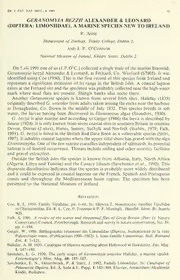
Geranomyia bezzii Alexander & Leonard (Diptera: Limoniidae), a marine species new to Ireland PDF
Preview Geranomyia bezzii Alexander & Leonard (Diptera: Limoniidae), a marine species new to Ireland
BR. J. ENT. NAT. HIST.,6: 1993 45 GERANOMYIA BEZZII ALEXANDER & LEONARD (DIPTERA: LIMONIIDAE), A MARINE SPECIES NEW TO IRELAND P. Ashe Department ofZoology, Trinity College, Dublin 2. AND J. P. O'Connor NationalMuseum ofIreland, Kildare Street, Dublin 2. On S.vii.1991 oneofus(J.P.O'C.)collectedasinglemaleofthemarinelimoniid, Geranomyia ftezz/YAlexander & Leonard, at Fethard, Co. Wexford (S7905). It was identified using Coe (1950). This is the first record ofthis species from Ireland and represents a significant extension of its range in the British Isles. A coastal lagoon existsat theFethard siteandthespecimenwasprobablycollectednearthehigh-water mark where mud flats are present. Shingle banks also occur there. Another Geranomyia species is known from several Irish sites. Haliday (1833) originallydescribed G. unicolorfromadultstaken amongtherocks neartheharbour at Donaghadee, Co. Down in the middle of July 1832. This species breeds in salt water, the larvae having been discovered in filamentous algae (Saunders, 1930). G. bezzii is also marine and according to Geiger (1986) the larva is described by Seurat(1924). ItisonlyknownfromsevencoastalsitesinsouthernBritainincounties Devon, Dorset (2 sites), Hants, Sussex, Suffolk and Norfolk (Stubbs, 1978; Falk, 1991). G. bezziiis listed in the British Red Data Book as a vulnerable species (Shirt, 1987). It inhabitscoastallagoonswheretheuppertidalshorehasgravelwiththealga Enteromorpha. Oneofthefewmarinecranefliesindependentofsaltmarsh,itspotential habitat is oflimited occurrence. Threats include saihng and other amenity facilities and gravel extraction. Outside the British Isles the species is known from Albania, Italy, North Africa (Algeria, Libya and Tunisia) and the Canary Islands (Savchenko etal., 1992). This disparate distribution indicates that the species is probably more widely distributed and it could be expected in coastal lagoons on the French, Spanish and Portuguese coasts and throughout the Mediterranean basin region. The specimen has been presented to the National Museum of Ireland. References Coe, R. L. 1950. Family Tipulidae, pp. 1-66. In: Diptera 2. Nematocera: families Tipulidae toChironomidae.Ed. R.L.Coe,P. Freeman&P. F. Mattingly.Handbk.Ident.Br.Insects 9(2). Falk, S. 1991. A review ofthescarce and threatenedflies ofGreat Britain (Part 1). Nature ConservancyCouncil,Peterborough. Researchandsurveyinnatureconservation,No. 39, pp. 1-194. Geiger, W. 1986. Bibliographic raisonnee des Limoniidae (Diptera, Nematocera) de la zone Palearctiqueouest. (Publications 1900-1982). I. Sous-famille Limoniinae. Bull. Romand Ent. 4: 3-121. Haliday, A. H. 1833. CatalogueofDipteraoccurringabout HolywoodinDownshire.Ent.Mag. 1: 147-180. Saunders, L. 0. 1930. The early stages of Geranomyia unicolor Haliday, a marine tipulid. Entomologist's Mon. Mag. 60: 185-187. Savchenko, E. N., Oosterbroek, P. & Stary, J. 1992. Family Limoniidae. In: Catalogue of PalaearcticDiptera. Ed. A. Soos& L. Papp. 1: 183-369. Elsevier, Amsterdam/Akademiai Kiado, Budapest. 46 BR. J. ENT. NAT. HIST.,6: 1993 Seurat, L. G. 1924. Moeurs et evolution d'un Tipulide a larve et nymphe marines. Bull. Soc. Hist. Nat. Afr. N. 15: 113-121. Shirt,D. B. 1987.Britishreddatabooks:2.Insects.NatureConservancyCouncil, Peterborough. Stubbs, A. E. 1978. The sea shore and cliffs, pp. 129-132. In: A diplerisl's handbook. Ed. A. Stubbs & P. J. Chandler. Amat. Ent. 15: 1-255. ANNOUNCEMENTS — — Larvae of the British macrolepidoptera a plea. Those who have attended the annual exhibition over the last few years will be aware of the work being done to photograph the larvae of all the butterflies and larger moths. All except about 30 have now been photographed, and text is being prepared for eventual publication. While we accept that we can never expect to find every species that is on the British list, it should still be possible to find some ofthese 30 species. We therefore appeal toallBritish andContinentallepidopteriststomakeeveryefforttomakethisimportant workascompleteaspossible. What isneededarethelarvae, or femalesorovawhich might lead to the species being bred, or alternatively, good quality slides. British or foreign material is acceptable. The larvae required are: hecta
